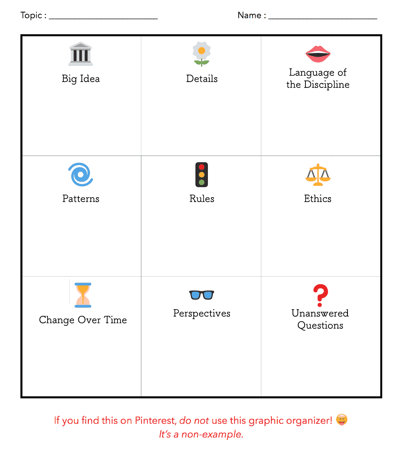The most common mistake I’d make when implementing the Depth and Complexity thinking tools was to rely on graphic organizers like this:

Here are three problems with this Depth and Complexity worksheet:
1. Too many prompts!
In this case, there are so many prompts of depth, that students will rush through to complete it all, leading to (ironically!) shallow thinking. This worksheet becomes a checklist rather than a tool for deep-thinking. After all, how can a student go deep in nine different directions at once? When I’m cooking, I never use all of my spices. When using the prompts of Depth and Complexity, we should never use all of the prompts at once. Carefully pick the perfect one or two prompts that will enhance your question. Oh, that brings me to Problem 2. These aren’t questions at all!
2. No questions!
The icons are just sitting there by themselves. What are students supposed to do with the prompts? How should they be thinking about “rules”? If I don’t make this clear, my students will default to the lowest level of thinking. They’ll just list three rules, three details, three patterns, and so on. Listing three rules is not very deep thinking! I need to write out high-level questions, not just plop an icon down (see more on that here).
3. No connection to content.
This worksheet is sick with Vagueness Disease. It tries to work with any topic and, as a result, works with nothing. You cannot ask a great question if you don’t know the topic you’re asking about! I’d want to ask my students questions that are carefully designed to push their thinking deeper into the content. A one-size-fits-all worksheet cannot do that.
How To Do It better
- Pick the perfect prompts for the task. Sometimes it might be two or three, but never nine or ten! If I’m studying Rosa Parks, I’ll probably pick ethics, rules, and multiple perspectives. Sure, I could use all the prompts (they all “work”), but these three set the stage for a specific task I have in mind. You might pick three different prompts to focus on – but do pick that focus with purpose.
- Always pair Depth and Complexity prompts with a thinking skill. Use Bloom’s Taxonomy to rise above the “find three examples” level of thinking. Never let the prompt sit by itself or kids will default to “listing”.
- Think about your learning goal. Is it for students to fill in a worksheet? That’s neither deep nor complex. Instead, consider how to set the stage for slow, deep learning, using the prompts as a tool to get there.
Questions? Examples? Anecdotes? Send them to ian@byrdseed.com.

